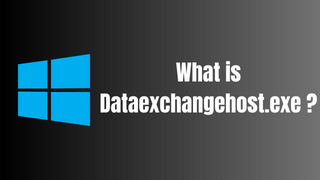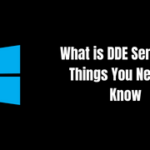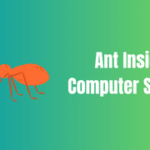We live in an age where the rapid advances in technology make things more and more seamless. These seamless processes often run in the background, largely unnoticed. One such unsung hero is the DataExchangeHost.exe. It plays a silent but critical role in your day-to-day computing experiences.
Table of Contents
A Deep Dive into DataExchangeHost.exe

At its core, DataExchangeHost.exe is a system process associated with the smooth running of your computer’s operations. You can think of it as the stagehand that’s invisibly coordinating all elements of a performance – in this case, the performance being the seamless functioning of your computer.
The role of DataExchangeHost.exe isn’t limited to just one function. Its main purpose is to facilitate drag and drop operations between the guest and host in a virtual machine setup. Whether you are working on a Windows 10 Home system or using a computer like the HP Pavilion, the chances are high that this process is working tirelessly in the background.
Using the DataExchangeHost.exe process, applications on the host and guest systems can communicate efficiently, ensuring you can move data between systems without any hiccups. For instance, when you’re knee-deep in complex processes involving the Java Development Kit, or Python, or even while you’re catching up on your emails via Outlook, DataExchangeHost.exe is at work, ensuring your workflows remain smooth.
“The advance of technology is based on making it fit in so that you don’t really even notice it, so it’s part of everyday life.”
-Bill Gates
This encapsulates the purpose of DataExchangeHost.exe in our digital lives.
An Indispensable Part of the Bigger Picture

Understanding the role of DataExchangeHost.exe gives us an insight into the intricate workings of our technological world. This humble process plays a crucial role in the context of workgroups operating under the Microsoft Azure Cloud Service.
Every bit of data that you exchange, every file that you drag and drop – the DataExchangeHost.exe is silently ensuring the smooth transition of your data from point A to point B.
To make things more clear, here’s a table summarizing the significant responsibilities of DataExchangeHost.exe:
| Role | Description |
|---|---|
| Drag and Drop Operations | Facilitates data movement between host and guest systems |
| Data Exchange | Ensures seamless data transfer |
| Application Interaction | Enables host and guest applications to communicate |
The Security Aspects of DataExchangeHost.exe

Like any other system process, DataExchangeHost.exe is generally safe. However, in the tech world, there is always the risk of processes getting disguised by malware. If you notice that DataExchangeHost.exe is consuming excessive resources in your Task Manager, it’s crucial to run a thorough check.
Security scans using reputed software like Malwarebytes, McAfee, or Windows Defender can help identify any potential risks. If there’s any unusual activity in the Event Viewer marked as EventID, that might also be an indication of a potential problem.
In case of any persistent issues with DataExchangeHost.exe, the Microsoft Safety Scanner or generating FRST Logs can help diagnose and address the problem.
The Role of DataExchangeHost.exe in the Tech Ecosystem
From a broader perspective, DataExchangeHost.exe is a critical component in the modern tech ecosystem. As more and more businesses migrate to cloud-based solutions, the role of processes like DataExchangeHost.exe becomes even more pivotal.
Processes such as these form the backbone of many of our routine tech interactions. They ensure seamless collaboration between different systems and applications, ensuring the user has a smooth and efficient experience.
Delving Deeper: The Power Behind DataExchangeHost.exe
Looking at it from a broader perspective, the DataExchangeHost.exe is the linchpin holding together a variety of operations. It essentially allows your computing system to multi-task, juggling a series of operations simultaneously.
Think of your computer as an international conference, with representatives from various applications speaking different languages. DataExchangeHost.exe would be the expert interpreter ensuring clear communication across all parties. It translates and routes messages across different applications, enabling them to work together smoothly.
Furthermore, in a more advanced setting such as a workgroup in a cloud service like Microsoft Azure, it plays an even more critical role. With a large number of virtual machines running simultaneously, the importance of efficient data transfer becomes paramount.
The Unseen Protector: DataExchangeHost.exe and Security
While DataExchangeHost.exe is generally safe and essential for system operations, the cyber world’s vulnerabilities can sometimes make it a target. Malware can disguise itself as this system process, becoming a Trojan horse to invade your system.
If DataExchangeHost.exe is consuming a significant portion of system resources visible in the Task Manager, it might not be the genuine process. The first line of defense is a thorough antivirus scan using trusted software like Malwarebytes, McAfee, or Windows Defender.
Additional tools like the Microsoft Safety Scanner can also help diagnose problems, providing an extra layer of protection. If issues persist, generating FRST Logs can give you a more detailed view of your system’s operations, assisting in troubleshooting.
DataExchangeHost.exe in the Ever-Evolving Technological Landscape
As we continue to advance in technology, system processes like DataExchangeHost.exe are becoming even more important. The increased use of virtual machines in the modern tech landscape has made the role of such processes pivotal.
Cloud computing is now an integral part of many businesses, with services like Microsoft Azure leading the way. In this context, DataExchangeHost.exe plays a vital role in ensuring that data can be moved smoothly between different systems and platforms.
As technology progresses, we may witness DataExchangeHost.exe evolve and adapt to meet new requirements. Just as Python and Java have evolved over time to meet the changing needs of developers, so too will system processes like DataExchangeHost.exe to keep pace with the evolving digital world.
A Final Word And FAQ
To that end, DataExchangeHost.exe is a pivotal piece of modern technology that, while not necessarily seen or appreciated, is crucial in our everyday digital experiences. The next time you drag a file from your host to a virtual machine, remember the unseen maestro, DataExchangeHost.exe, working tirelessly behind the scenes.
Indeed, understanding these processes not only helps us appreciate the complexity and beauty of our digital world but also equips us to navigate any potential hiccups along the way. Here’s to the unsung heroes of the computing world, like DataExchangeHost.exe, that ensure our digital lives run smoothly and efficiently. Read more on fulltechguides;
Should DataExchangeHost.exe always be running in Task Manager?
In general, yes. It’s part of the normal operation of your system. However, if it’s consuming an inordinate amount of resources, it could indicate an issue.
How to know if DataExchangeHost.exe is a virus or malware?
While it’s typically safe, it can sometimes be masqueraded by malware. Run a security scan using software like Malwarebytes, McAfee, or Windows Defender to ensure your system is safe. Moreover, look into Event Viewer for unusual activity marked as EventID: 86.
What to do if DataExchangeHost.exe is causing a problem?
First, take a deep breath. Problems are part and parcel of the digital world. Run antivirus scans to check for malware. If the issue persists, consider using the Microsoft Safety Scanner or generating FRST Logs to diagnose the issue.
Source : Virtual PC – Wikipedia










